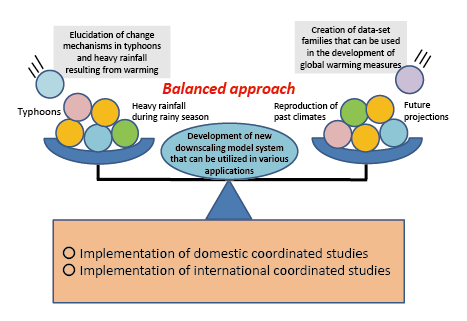International society is seeking stronger cooperation with “the physical science basis” of Working Group I (WGI) and “Impacts, adaptation and vulnerability” of Working Group II (WGII) within the Intergovernmental Panel on Climate Change (IPCC). In Japan, the development of global warming adaptation measures for all the local government units and various types of information on warming projections for use in those measures are being sought.
Among warming projections the change in the probability of extreme weather, for example typhoons and heavy rainfall during the rainy season, has recently drawn a lot of attention. High-resolution and precise global and regional climate models will be used in this theme and with the aim of elucidating how and why extreme weather changes that can have such a major impact on regional climates occur. The data from warming projection calculations can then be used to examine the types of impact they will have on society. Data that meets all of the types of demand for it therefore needs to be output.
We intend to carry out future projections and experiments for use in reproducing current climates in various scenarios and experiments that reproduce past climates through assimilating data. Then by assessing the adequacy of the resulting data we can provide the various users of it with guidelines for them to use in making the decision on which data they can best use. In addition, the intention is to develop a new and high-resolution downscaling model system to ensure that the data can then be utilized in a greater variety of fields and in warming impact assessment of environmental contamination, and in agriculture and renewable energy etc. The studies will be used in coordinated studies that include staff exchanges with other countries that are vulnerable to global warming (e.g. Southeast Asian countries) as well as in domestic coordinated studies. In this way the studies can then contribute to warming projections for use at actual sites and studies on their utilization.
| Subject | Representative | |
|---|---|---|
| (ⅰ)Development of high-precision models integrated with climate-relevant processes | Masayoshi Ishii Japan Meteorological Business Support Center |
|
| (ⅱ)Development of climate scenarios for multi-stakeholder applications and understanding the mechanisms of climate change | ||
| a | Development of climate scenarios for multi-stakeholder applications and understanding the mechanisms of future changes in extreme events | Toshiyuki Nakaegawa Japan Meteorological Business Support Center |
| b | High-resolution simulation of typhoons and extreme events | Tsuboki Kazuhisa Institute for Space-Earth Environmental Research, Nagoya University, Professor |
| (ⅲ)Advancing international collaboration through the application of a high-performing climate model over many countries in the Asia-Pacific region | Hidetaka Sasaki Japan Meteorological Business Support Center |
|


